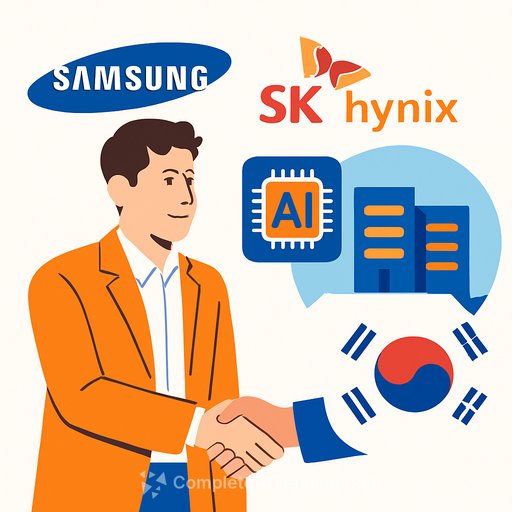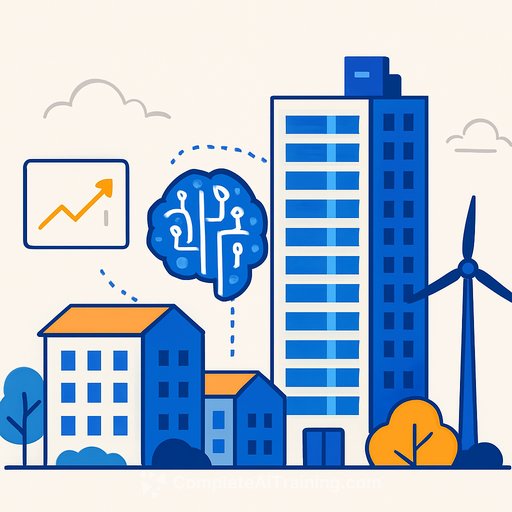Altman signs AI chip deals with Samsung and SK Hynix, adds new data centers in Korea: implications for real estate and construction
OpenAI CEO Sam Altman signed partnership deals with Samsung and SK Hynix to supply AI-focused memory chips for the Stargate project, a $500 billion infrastructure venture backed by OpenAI, Oracle, and SoftBank in the United States. During his visit to Seoul, Altman also agreed with President Lee Jae Myung to set up two new AI data centers in Korea.
South Korea's AI demand is surging, driven by strong ChatGPT adoption. The country lacks sufficient computing capacity, and these moves point to a development cycle that will lean hard on power, land, fiber, and specialized construction.
Key facts at a glance
- Partners: OpenAI, Samsung, SK Hynix; government meetings included President Lee Jae Myung.
- Chip supply: Up to 900,000 high-performance DRAM chips per month for Stargate, including high-bandwidth memory (HBM).
- New builds: Agreement to establish two AI data centers in Korea.
- Existing pipeline: AWS-SK data center in Ulsan (41 MW by 2027; 103 MW by 2029; $5.1B investment). IGIS to build two AI data centers in Busan (40 MW and 80 MW; construction starts late 2026; operations by late 2029; $1.3B).
"We're very excited to get to build Stargate Korea and data centers with our wonderful partners to support the sovereign AI needs of Korea," Altman said. President Lee said the three-way partnership will "lead the global market" and expand exports and jobs. Samsung Chairman Lee Jae-yong said the move helps Korea "stand at the center of the global AI paradigm."
Why this matters for developers, GCs, and investors
Hyperscale AI facilities require large, well-served sites, fast-track permitting, and deep coordination with utilities. Expect higher demand around Seoul's major corridors and secondary markets like Ulsan and Busan that offer port access and growing grid capacity.
Competition for industrial land near high-capacity substations and diverse fiber routes will intensify. Land assemblage, rights-of-way, and redundancy planning will be early differentiators.
Power and cooling: plan for high density
- Capacity: Announced sites range from 40 MW to 103 MW, with room for expansion. Design for phased energization and clear PPA or interconnection milestones.
- Electrical: Substation builds and transmission upgrades are often the critical path; secure transformer and switchgear early.
- Cooling: Next-gen AI workloads push liquid-ready designs. Validate water availability, reclaim water options, and heat reuse. Tighten acoustic controls for high CFM or cooling tower strategies.
- Resilience: Dual-feed power, on-site generation strategies, and N+N cooling where required by tenant SLAs.
Sites, permitting, and incentives
Line up zoning, environmental impact studies, and noise/traffic plans early, especially near residential edges. Local and national incentives are likely to favor high-capex builds, domestic supply chains, and workforce development-bring clear job numbers and training plans to the table.
Proximity to ports (heavy equipment), highways (modular deliveries), and diverse long-haul fiber should be in the initial screening criteria. Seismic, flood, and wind risk mapping remains non-negotiable.
Supply chain and schedule risk
HBM and DRAM supply will influence server delivery pacing, which cascades into MEP phasing. Long-lead items-generators, chillers, power transformers, medium-voltage gear-need pre-buys and framework agreements.
Consider offsite manufacturing for electrical rooms and cooling skids to compress schedule and reduce on-site congestion. Lock in QA/QC and factory acceptance testing windows before grid dates are set.
Active pipeline to monitor
- Ulsan: AWS-SK project (41 MW by 2027; 103 MW by 2029; $5.1B). Expect phased procurement, with early civil works and utility coordination running in parallel.
- Busan: IGIS projects (40 MW and 80 MW; construction late 2026; operations late 2029; $1.3B). Port proximity supports heavy equipment logistics and modular strategies.
- New agreement: Two additional AI data centers tied to the Altman-Lee announcement. Watch for RFPs on design-build, EPC, and O&M.
Action checklist
- Secure power: Begin interconnection studies and transformer reservations now; align with utility build cycles.
- Prequal vendors: Build a bench for liquid cooling, high-density racks, MV gear, and fiber diversity.
- Site control: Target parcels with substation adjacency, multi-carrier fiber, and expansion potential.
- Permitting path: Prepare EIA, noise/traffic, and water use plans early to shorten approvals.
- Delivery model: Use phased, modular construction to match chip/server deliveries and de-risk cash flow.
- Talent pipeline: Stand up training for data center PMs, commissioning agents, and facilities techs.
Context and resources
For a technical primer on HBM referenced in these deals, see the JEDEC standard for High Bandwidth Memory here.
If you're upskilling teams for AI-related development and operations, explore role-based learning paths at Complete AI Training.
Your membership also unlocks:






